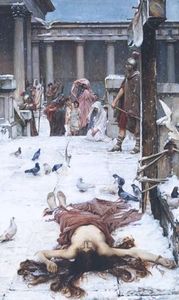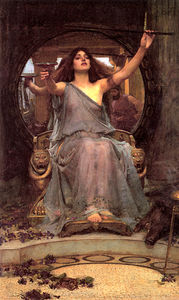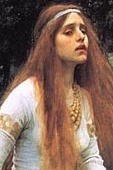John William Waterhouse Style and Technique
- Full Name:
- John William Waterhouse
- Short Name:
- Waterhouse
- Date of Birth:
- 06 Apr 1849
- Date of Death:
- 10 Feb 1917
- Focus:
- Paintings
- Mediums:
- Oil, Watercolor
- Subjects:
- Figure
- Art Movement:
- Romanticism
- Hometown:
- Rome, Italy
- John William Waterhouse Style and Technique Page's Content
- Introduction
- Style
- Method
Introduction
John William Waterhouse created paintings in the Romantic style. Producing work mainly in oils, his canvases consist of realistic and natural settings. The artist's fascination with beautiful heroines and the femme fatale is unquestionable and he portrays theme using symbolism, vivid color schemes, and beautiful light.
John William Waterhouse Style
Waterhouse is often classed as a Pre-Raphaelite painter, because of his dedication to painting beautiful women, fondness of the femme fatale, and realism. His most Pre-Raphaelite painting is The Lady of Shalott which he finished in 1888. Often drawing on well-known stories or myths, scholars identified Waterhouse's liking for choosing tragic or brutal stories and yet finding the beauty or calm in them.
One example of this is, St. Eulalia, the story of a young Spanish girl who was horribly martyred in Roman times. In stead of showing some of her horrific injuries or the act of martyrdom, Waterhouse depicts her lifeless body almost in calm. Her mutilated torso is partially covered in red robes and the snow falling around makes the scene almost otherworldly and magical.
One painting which uses almost all of Waterhouse's compositional techniques is Circe Offering the Cup to Ulysses. The moment Waterhouse captures is when the witch Circe is about to trick the hero Ulysses. Waterhouse paints her in a raised seat, with her face turned upwards, looking down on the viewer.
This superior stance indicates the power the woman has over others. The chair and mirror behind Circe act to frame her body, almost like a throne.
Waterhouse often chose to paint stories which were about heroic male characters and yet in his paintings they became background characters, their faces are turned away or partially covered. This technique allowed Waterhouse to focus on his passion, the beautiful heroine, whist often indicating how the viewer should be interpreting the woman in front of them.
For instance in Circe Offering the Cup to Ulysses, Ulysses can just be seen in the mirror, small in comparison to Circe and with his head slightly bowed. This again indicates the woman's superior status.
Waterhouse also used mirrors and windows in the background on his paintings to further develop narrative, examples include Circe Offering the Cup to Ulysses and his series of The Lady of Shalott paintings. In the latter case the mirror in which the lady can look through to the real world, is used to show Lancelot riding by as he does in Tennyson's poem.
Waterhouse always creates luminous porcelain skin for his women making them look pure, innocent and ethereal. The skin tone was undoubtedly fashionable and considered the height of beauty in Waterhouse's Victorian England. This light skin is often contrasted with dark eyes and titian hair.
The artist created equal detail in the background of his paintings as he does his foreground and this is complimented by his use of color throughout. The colors used in the background are often muted so as not to distract from the main scene and yet they also reflect the feel and mood of the piece.
The style of clothing which Waterhouse places his women in is ultimately romantic. A cross between medieval and Greco-Roman, the artist uses drapery to create movement. Waterhouse also uses color to represent the characteristic of the person portrayed. For instance, dark blues of purples are often used for dangerous or powerful women. Pinks and softer shades are more commonly used for lighter moods. Translucent fabric is used to create subtle sexuality for the women, without them being completely nude or too provocative.
Waterhouse manages to create a great deal of movement in his paintings and this helps to add realism, the viewer feels like they are almost in the scene as well.
In order to do this he uses light and shadow, and creates rippling clothes and wild hair. The level of detail in Waterhouse paintings certainly helps to create this movement, without the paintings would become dreamy and unrealistic.
Like the Pre-Raphaelite brotherhood from which Waterhouse took so much inspiration he used symbolism to establish key themes in each piece, giving a narrative to his paintings.
In his pieces which contain women weaving, such as The Lady of Shalott, the artist uses the act of weaving as a symbol of the women's stagnate life, constantly waiting and filling her time with idle pursuits. Although one of Waterhouse's primary concerns was beauty, this symbolism shows that as with other pre-Raphaelite artists, he also felt that art should have a meaning. Waterhouse often created several studies of the same story of person and with this showed his ability to depict and alter characters. This not only captivates the viewer but shows his development as an artist.
John William Waterhouse Method
Like many of the other artists of his generation Waterhouse used real life models when sketching or painting. Although there is no formal record of the sitter he used, personal letters by the artist show that his wife, sister, and sister-in-law all modeled for him at certain times. Famous models of the day including Jennifer Flora and Beatrice Flaxman also feature in some of his paintings.





